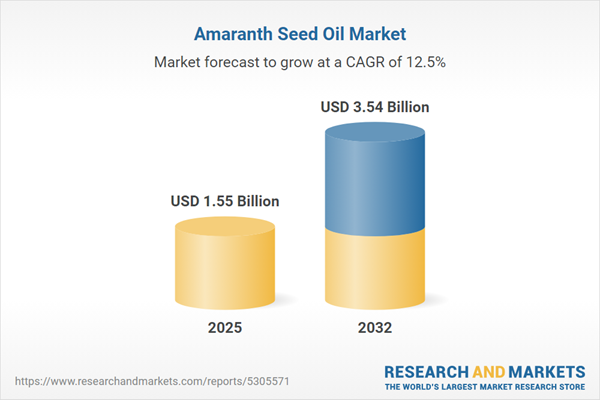Speak directly to the analyst to clarify any post sales queries you may have.
Amaranth seed oil is gaining importance with senior executives who prioritize innovation, resilient supply chains, and sustainability. Its role spans multiple industries, making it an essential element in shaping forward-looking business strategies.
Market Snapshot: Amaranth Seed Oil Market Growth and Outlook
The amaranth seed oil market is forecast for robust expansion through 2032, driven by increased demand from the health, nutraceutical, and cosmetics industries. The shift toward clean-label products is setting new expectations for transparency, influencing executive approaches to sourcing. Agile market players are adapting rapidly to meet evolving buyer requirements, navigate updated regulatory frameworks, and accelerate innovation cycles. Organizations that prioritize responsive supply networks and specialized product development can access significant value in a market characterized by changing consumer priorities and heightened competition.
Scope & Segmentation: Amaranth Seed Oil Market
- Grade: Cosmetic-grade amaranth seed oil serves the needs of skincare and personal care product manufacturers. Food-grade variants are tailored to safety and sensory criteria for edible use, while pharmaceutical-grade oil meets therapeutic and supplement application standards, broadening adoption across key industries.
- Form: Encapsulated powder, achieved through spray drying or microencapsulation, allows for precision in advanced ingredient formulations. Liquid oil formats provide flexibility for both nutrition blends and topical applications, supporting varied production processes.
- Extraction Technology: Cold pressing, solvent extraction, and supercritical CO2 extraction increase options for purity and quality control. These techniques help manufacturers meet regulatory guidelines and develop products for specialized markets.
- End Use: Applications extend from animal feed and dietary supplements to functional foods, beverages, cosmetics, personal care, and pharmaceuticals, allowing suppliers to respond to industry shifts.
- Sales Channel: Distribution comprises pharmacies and specialty retailers as well as rapidly growing online channels, enhancing product accessibility for diverse business models.
- Region: Operations span the Americas, Europe, Middle East and Africa, and Asia-Pacific. Each region presents unique regulatory frameworks and resource opportunities, shaping localized strategies for growth and collaboration.
- Key Companies: Leading players like Koninklijke DSM N.V., BASF SE, Croda International Plc, Evonik Industries AG, Kemin Industries Inc., Bioriginal Food & Science Corp., AIDP Inc., Aquaterra Nutrition LLC, SanaBio GmbH, and The Sun LLC define benchmarks for innovation and supply.
Key Takeaways for Decision-Makers
- The distinctive bioactive profile of amaranth seed oil—including squalene, unsaturated fatty acids, antioxidants, and tocopherols—supports innovation in health, wellness, and beauty applications, while offering room for expansion into other sectors.
- Advanced extraction methods help companies maintain rigorous purity standards, contributing to elevated brand positioning and adherence to strict compliance requirements in targeted industries.
- Sustainable sourcing practices such as regenerative and closed-loop systems foster transparent, responsible ingredient supply and align with Environmental, Social, and Governance (ESG) goals.
- Enhanced traceability, from initial raw material sourcing to final goods, strengthens risk management as global compliance expectations become more stringent.
- Flexible sourcing strategies empower organizations to reinforce supply chain continuity, protecting business operations from the impact of market volatility or regulatory changes.
Tariff Impact: Managing Shifts in U.S. Trade Policy
Recent adjustments to U.S. tariffs on amaranth seed imports are prompting companies to review and diversify sourcing and distribution strategies. Establishing supplier partnerships in regions such as Latin America and Asia, and exploring near-shoring alternatives, enables organizations to enhance supply stability while upholding quality in response to evolving trade policy.
Methodology & Data Sources
This market analysis combines insights from technologists, product specialists, and compliance experts. It assesses global trade flows, regulatory changes, and uses established models such as SWOT, PESTEL, and Porter’s Five Forces to deliver strategic recommendations tailored for senior executive teams.
Why This Report Matters for Amaranth Seed Oil Market Stakeholders
- Equips leaders with tools to drive sustainable sourcing and refine supply chain strategies amid complex regulatory demands.
- Clarifies how technological advances and regulatory shifts converge to inform actionable, forward-focused executive decisions.
- Strengthens market segmentation, benchmarking, and resilience so organizations can navigate operational changes with confidence.
Conclusion
Progress in innovation, sustainability initiatives, and agile business approaches are essential for future leadership in the amaranth seed oil sector. This report offers senior decision-makers the insights needed to adapt as market expectations evolve.
Additional Product Information:
- Purchase of this report includes 1 year online access with quarterly updates.
- This report can be updated on request. Please contact our Customer Experience team using the Ask a Question widget on our website.
Table of Contents
3. Executive Summary
4. Market Overview
7. Cumulative Impact of Artificial Intelligence 2025
Companies Mentioned
The companies profiled in this Amaranth Seed Oil market report include:- Koninklijke DSM N.V.
- BASF SE
- Croda International Plc
- Evonik Industries AG
- Kemin Industries, Inc.
- Bioriginal Food & Science Corp.
- AIDP, Inc.
- Aquaterra Nutrition, LLC
- SanaBio GmbH
- The Sun LLC
Table Information
| Report Attribute | Details |
|---|---|
| No. of Pages | 185 |
| Published | October 2025 |
| Forecast Period | 2025 - 2032 |
| Estimated Market Value ( USD | $ 1.55 Billion |
| Forecasted Market Value ( USD | $ 3.54 Billion |
| Compound Annual Growth Rate | 12.4% |
| Regions Covered | Global |
| No. of Companies Mentioned | 11 |









